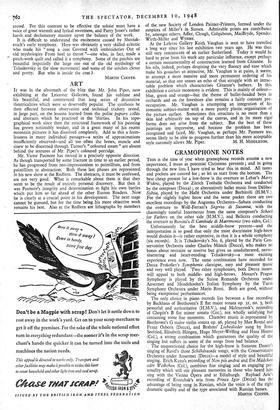GRAMOPHONE NOTES
Tins is the time of year when gramophone records assume a new importance, I mean as potential Christmas presents ; and in going through the new lists I have tried to bear this in mind. All tastes and pockets are catered for ; so let us start from the bottom. The best cheap present for a low-brow is the overture to Lehar's Merry Widow, played by the Zurich Tonhalle Orchestra and conducted by the composer (Decca) ; or alternatively ballet music from Delibes' Sylvia, played by the Halle Orchestra under Barbirolli (H.M.V.). For the slightly higher brow and the same pocket there are two excellent recordings by the Augusteo Orchestra—Sabata conducting the overture to Wolf-Ferrari's Segreto di Susanna, with the charmingly tuneful Intermezzo from the same composer's School for Fathers on the other side (H.M.V.), and Bellezza conducting the overture to Rossini's II Cambiale di Matrimonio (two sides, Col.).
Unfortunately far the best middle-brow present—and the interpretation is so good that only the most doctrinaire high-brow would disdain it—is rather expensive, in that it is a whole symphony (six records). It is Tchaikovsky's No. 6, played by the Paris Con- servatoire Orchestra under Charles Munch (Decca), who makes no bones about restraint or reserve but gives us unadulterated, nerve- shattering and heart-rending Tchaikovsky—a most exciting experience even now. The same combination have recorded for Decca Prokofiev's Symphonie classique, easy and pleasant music and very well played. Two other symphonies, both Decca issues, will appeal to both middle- and high-brows. Mozart's Prague Symphony is played by the Suisse Romande Orchestra under Ansermet and Mendelssohn's Italian Symphony by the Turin Symphony Orchestra under Mario Rossi. Both are good, without being exceptional performances.
The only choice in piano records lies between a fine recording by Backhaus of Beethoven's E flat major sonata op. 31, no. 3, both powerful and authoritative (H.M.V.), and Malcuzynsk's recording of Chopin's B flat minor sonata (Col.), not wholly satisfying but containing some fine moments. Chamber music is represented by Beethoven's G major violin sonata op. 96, played by Max iz ostal and Franz Osborn (Decca), and Brahms' Liebeslieder sung by Irma Seefried, Elisabeth Hongen, Hugo Meyer-Welfing and Hans Hotter (Col.), a strong combination which guarantees the quality of the singing but suffers in some of the songs from bad balance.
The unquestioned choice for the high-brow is Suzanne Danco's singing of Ravel's three Scheherazade songs, with the Conservatoire Orchestra under Ansermet (Decca)—a model of style and beautiful singing. Erich Kunz!s recording of Non pit andrai and EM Madchen oder W eibchen (Col.), combines fine singing and an engaging per- sonality which will stir pleasant memories in those who heard him sing with the Vienna Opera and at Edinburgh. Raphael Arie's recording of Kontchak's aria from Prince Igor (Decca) has the advantage of being sung in. Russian, while the voice is of the right dramatic quality and of the type associated with Russian basses.
MARTIN COOPER.














































 Previous page
Previous page